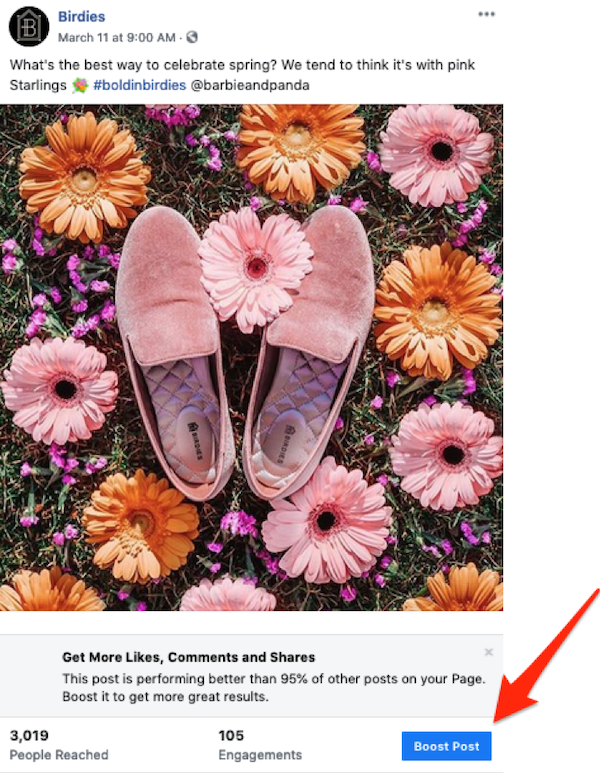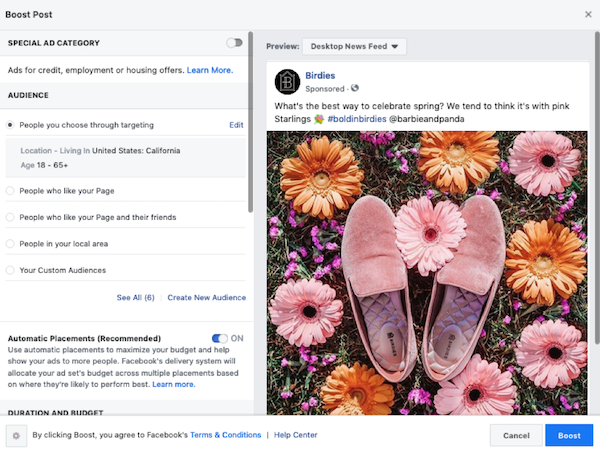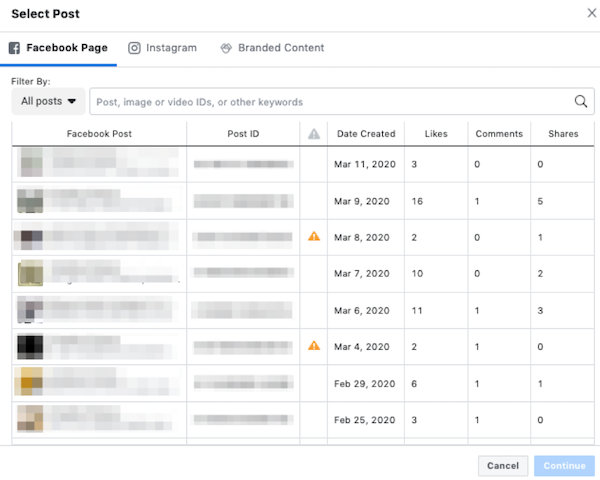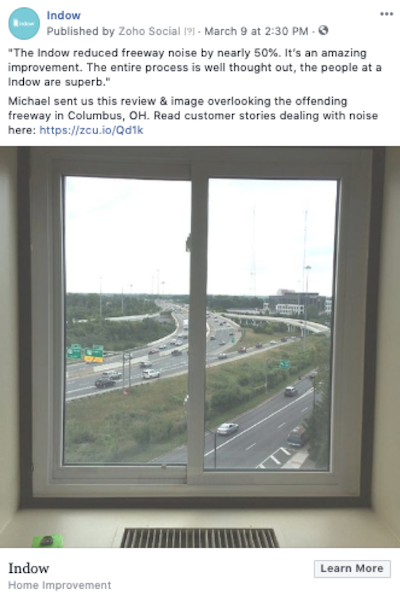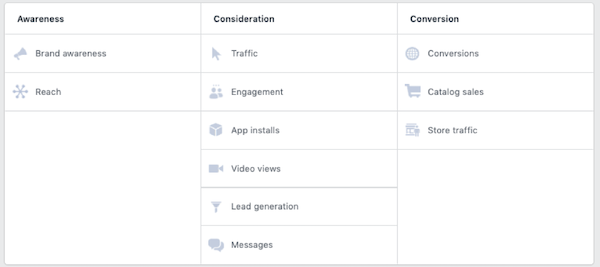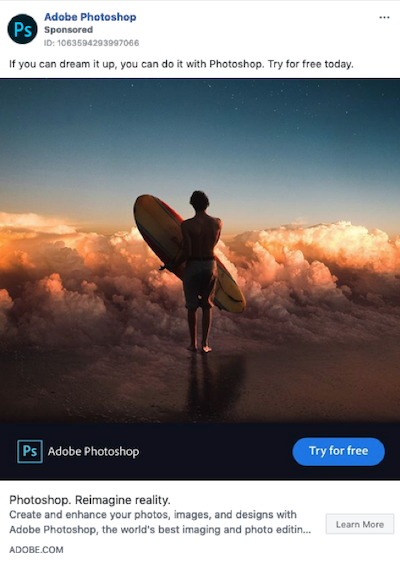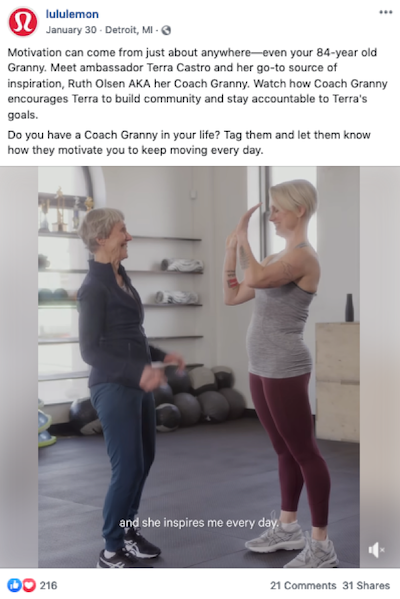If you’re finding that your organic posts on your Facebook business page aren’t getting the reach they once had, you are not alone. Over the years, as Facebook’s algorithm has continued to evolve and with more brands coming into the channel, organic reach has been dwindling further. If you’re lucky, you may get a full 1% of your fans that actually see your posts these days, but chances are low.
After all, as brands, we have to compete with personal user posts ranging from cat videos, baby photos, and other friend updates. The visibility in user feeds that we are vying for as brands is not what it once was and if you want more, you have to pay to play. One quick, easy, and affordable way to do that is to boost your organic posts through a sponsored post, or boosted post.
In this guide, we’ll cover:
- What Facebook sponsored posts are.
- How to run sponsored posts.
- How to fit them into your Facebook marketing strategy.
- How to make your sponsored posts successful.
Let’s get to it.
What is a Facebook sponsored post?
In a nutshell, it’s an ad created by using a post on your Facebook business page. If you want your organic post on your Facebook business Page to get more visibility and to reach new and/or larger audiences, you can boost, or promote your post. Your post will be seen by more people, can help drive more direct brand awareness and user engagement as well as indirectly impact website traffic if there is a link and possibly conversions, too.
How do I run a Facebook sponsored post?
There are two ways you can boost a post at this time: directly through your organic post or through Facebook Ads Manager. I’m going to walk you through both.
Set up directly through your organic post
Facebook makes it easy for small businesses and individuals to sponsor a post. While there are several ways you can boost a post, the quickest and easiest is directly on the organic post itself, on your Facebook business Page. On each of your posts, a blue “Boost Post” button can be found, as so:
Click the button on your post and allow the pop up window to present itself with the targeting, duration, budget, and conversion tracking options.
Images via Birdies
Here, you will want to select your audience or create a new one. If you want more of your fans to see it, you can target “people who like your page” or through some broader audiences to get in front of more new people and get them into your funnel. One of many ways that you can begin reaching people is to target people that live in a location that you can ship to or service and the age range that may be interested in your products or services. An effective way to reach new people is if you have any lead or customer email lists, import them into Audiences in Ads Manager and create a lookalike from them. Or you can take your website visitors or cart abandoners and create lookalike audiences off of those. Another way is that you can take an interest or behavior based targeting approach by targeting people that are interested in your types of offerings.
Next up, you can set the ad to run in all ad placements, as recommended in the “Automated Placements” area. I typically recommend running these to see how they perform with certain audiences and in which placements, they perform best. If you run your sponsored post for enough time (seven days max) and budget, you can later go into Facebook Ads Manager to run an ad placement report. If you see that an ad placement is under-performing, you can then go into your sponsored post campaign, to the ad set level, and edit the ad placements to unselect any of those under performers. This can help optimize, or improve, the performance of your particular sponsored post. You can also take the learnings of this sponsored post run and apply them to other campaigns if it makes sense to do so and see if its successful, there, too—and this will save you time and money on testing your copy and creatives with new audiences.
In the next area, you will set the duration and budget. Under “Tracking Conversions,” make sure the Facebook Pixel is selected and blue, meaning it is set up and active. This way, you will be able to track various actions, such clicks to your website if there is a link included in your post and conversions. If this is your first time running an ad on Facebook, you will need to add your payment information such as a debit or credit card before you can activate your boosted post. If you have run ads, your payment information should be on file. Lastly, click the “Boost” button and let it run!
Set up through Facebook Ads Manager
If you have some Facebook advertising experience, head over to Facebook Ads Manager and set up a campaign with any campaign objective that makes sense for your boosted post goal.
To set these up, head over to the ad level and where you select your creative, select “Use Existing Post.” A window will open where you will then be able to select a post from Facebook, Instagram, or branded content if another brand tagged you in a post of theirs. Please note, only Facebook branded content is available at this time. Instagram is not, but keep an eye on it as we imagine that it will be available in the near future.
While there are countless ways tactics, one way we set up sponsored posts through Ads Manager is in retargeting campaigns, where we are reaching warm audiences that have not yet converted. For example, our custom window insert client, Indow, has some interesting and informative organic posts we often boost in preexisting awareness campaigns to keep costs lower and to keep their brand and products top of mind with our warmer audiences that have indicated interest in their products with prior touch points but have not yet converted. By showing users posts with higher social proof and don’t necessarily push a hard sell, these ads convert very well and at lower costs. For example, we use customer stories, as seen here.
Facebook sponsored posts vs. traditional Facebook ads
Facebook sponsored posts are very easy to use, create, and launch, especially if you are a small business owner or an individual with limited or no Facebook Ads managing experience. These are also effective for short term runs, ranging from one to seven days in duration, whereas traditional ads can run long term. If you have any engagement, such as reactions, comments, or shares on your organic post, one of the benefits of boosting that post is that your engagement will also be promoted to the audiences you target, which increases your social proof. You can boost and re-boost your post across various audiences and the engagement will remain, even further increasing your social proof.
Another added benefit of choosing a sponsored post is that you can do it for a very low cost. With an affordable $1/day ad spend minimum on boosted posts, you can begin reaching people. Of course, the more budget you have, the more users you will reach, the quicker you can learn, and the faster you can optimize your posts and ads going forward with your learnings.
While Facebook sponsored posts are easy to set up, they do come with limitations, compared to what you would find in the more advanced advertising area of Facebook, in Ads Manager.
A traditional Facebook ad campaign and ads are set up in Ads Manager, where you can use many more features, see reporting, and make optimizations. Traditional Facebook ads provide you an option to select a campaign objective, such as awareness, engagement, website traffic, event attendance, mobile app installs, leads, or conversions, whereas, sponsored posts, do not. Sponsored posts are primarily effective in driving brand awareness and engagement, though, if you add a website link to your post, you can also indirectly drive website traffic as well.
With traditional ads, you can also set more advanced targeting options with inclusion and exclusion audiences, utilize bidding strategies, and optimization strategies such as landing page views, link clicks, conversions, and more. With more options, there is a level of complexity that can come into play—as well more time needed for set up—but the payoff can be much larger when setting up traditional ads.
There is much more flexibility in Facebook Ads Manager, which is worthwhile to explore. However, if you are looking to quickly and easily gain more traction on your organic posts in the interim, sponsored posts may better suit your needs.
How to add Facebook sponsored posts to your strategy
Sponsored posts perform best if they are run occasionally and alongside your traditional Facebook ads campaigns as these are short term and have limitations, thus, unable to solely achieve your lower funnel goals, like sales.
If you have an engaging post about an upcoming new product launch, a sneak peak post would make for an excellent sponsored post. If you have an already successful organic post, boost it further to new audiences that may also be interested. If you have a more expensive product or longer conversion funnel, target your warmer retargeting audiences with boosted posts to keep your brand top of mind.
While running an occasional sponsored post, set up campaigns in Facebook Ads Manager, too, to help drive more awareness by introducing people to your brand and then moving them down your funnel so that they eventually take the final action to complete your conversion. Think of traditional Facebook Ads as the foundation of your marketing efforts and sponsored posts as occasional bonus add ons to help with awareness and engagement.
How to create wow-worthy Facebook sponsored posts
Facebook sponsored posts might be easy to set up quickly, but these sponsored posts require thought and planning to be successful. Here are four ways to make sure your Facebook sponsored posts are wow-worthy.
Determine your goal
If you plan to use sponsored posts, be mindful of your goals. If your goal is to drive awareness and engagement, proceed with a boosted post. If you want something beyond that, such as driving more website traffic, mobile app installs, leads, and conversions, do so with traditional ads. The full list of available campaign objects can be seen here:
Harness high-quality posts
While you can promote just about any post from your business page, except for posts that you are featured in, photo albums, or mobile app install posts if that relates to your business, you will want to choose your highest quality posts to spend money on and promote. A high quality post users relevant and strong messaging, utilizes captivating creative that complements your text, and includes a call to action for users to take. Calls to action can be “Learn More,” “Shop Now,” “Donate Now,” “View More,” and so forth.
Captivate with your creative
Do you have a great image? Something bright, colorful, engaging? Boost it! Or perhaps you have an excellent video that you’re proud to show off? Boost it! Always aim to have a creative along with your text in a post so that you can maximize on your sponsored posts’s real estate. This way, as users scroll down their feeds, you can give them a reason for them to stop and see what you are sharing. One thing we have noticed that works very well, if relevant to your brand and post, is to use smiling people that may reflect your target audience. This makes the image, and the whole post, more relatable and click-worthy.
Select great social proof
If you have a post that has high organic engagement but you want to further increase that with a new audience, promote it and expand its reach and shelf life. People tend to engage with a post or an ad if more people already have. Plus, it helps if it is entertaining, inspiring, helpful, informative, and relatable, and even more so if you ask a question in your post, as the image below exemplifies.
Boost your bottom line with Facebook sponsored posts
Now that we’re familiar with the benefits, limitations, and best practices for Facebook sponsored posts, integrate them into your marketing strategy. Easily set them up and launch them to reach larger audiences, expand your reach and visibility, and drive more engagement. They’re an excellent and affordable way to get your feet wet with Facebook ads and to get new people into your funnel!
Read more:
